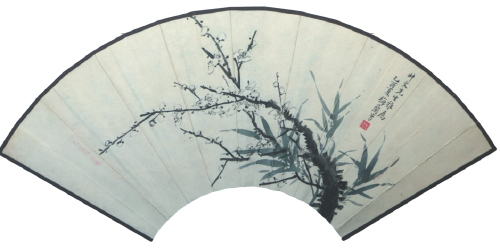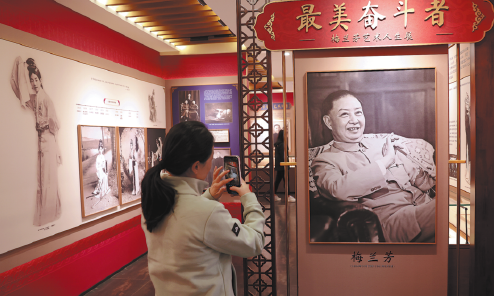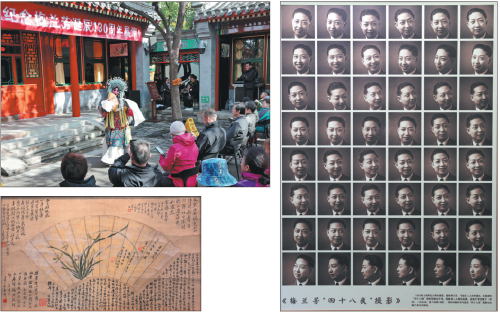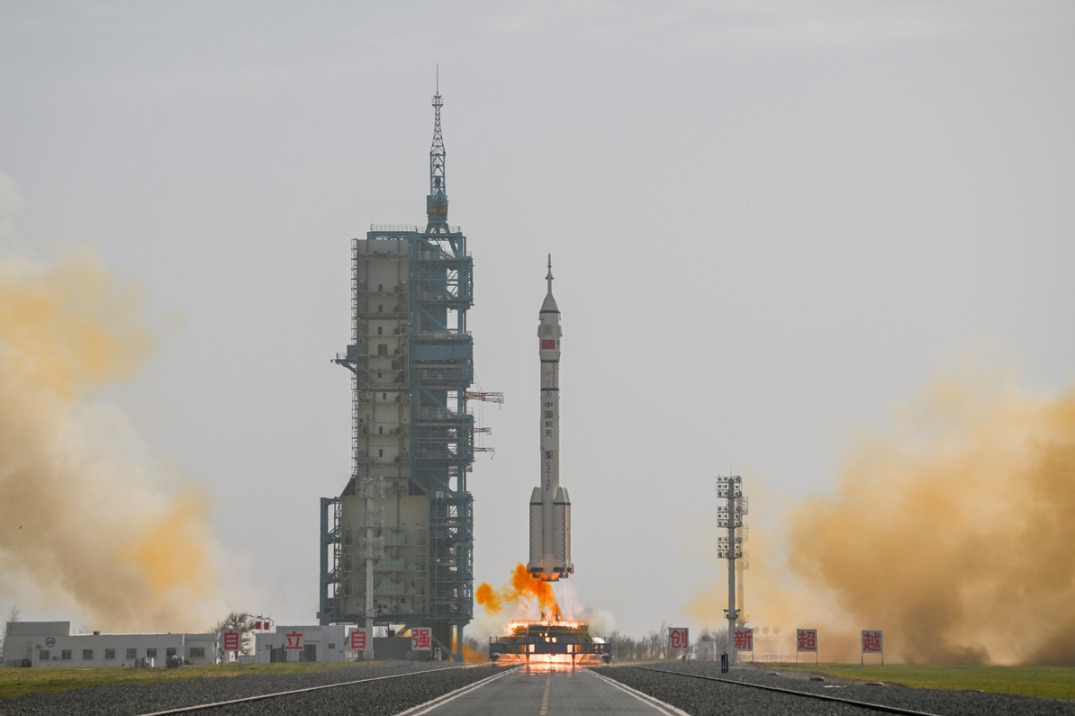Peeking deeper into famed Peking Opera performer's life
Renovated memorial hall explores artist's legacy with rare artifacts and interactive installations, Chen Nan reports.

Huguosi Street was one of Beijing's busiest commercial avenues back in the day.
Now, it is one of the most popular areas in the capital, where tourists get a taste of traditional architecture among the hutong, narrow alleyways, and local snacks.
One tour destination of Huguosi Street is the Mei Lanfang Memorial Hall, renovated from the famed Peking Opera master's former residence, which opened to the public in October 1986.
The hall, a tranquil courtyard of over 1,000 square meters and nestled in a hutong, preserves the intimate atmosphere of old Beijing, where traditional elements harmonize with its museum-like features, celebrating the legacy of Mei, whose life and artistry continue to resonate profoundly within Chinese culture and beyond.
The exterior retains its gray brick walls, wooden doors and lattice windows, all hallmarks of classic hutong structures. Upon entering, visitors step into a serene, rectangular courtyard framed by elegantly tiled eaves. The trees, rocks and potted plants evoke an ambiance of old Beijing life.
Renovation of the memorial hall started in May 2023 to expand the exhibition spaces and new displays. The memorial hall enhanced its collection, presenting rare artifacts, manuscripts and multimedia experiences to engage visitors of all ages, according to Li Lizhong, director of the hall.
With 2024 marking the 130th anniversary of Mei's birth, the hall held a reopening ceremony on Sept 20.
"Visitors can get closer to Mei Lanfang at this hall, where he lived from 1951 to 1961, the last 10 years of his life," says Li, adding that not far from Mei's residence, the first theater for Peking Opera performances opened in 1954, five years after the founding of the People's Republic of China. It was one of the theaters Mei performed in.
"The Mei Lanfang Memorial Hall now stands as a harmonious blend of the past and present, providing an immersive journey into the life of an opera legend. Visitors can explore not only Mei's artistic legacy but also the enduring allure of Peking Opera — now made accessible to a broader audience through modern technology," he says.
The centerpiece of the reopened hall is the new permanent exhibition Mei Lanfang's Artistic Life. This exhibition, spread across three rooms, showcases nearly 200 photographs and 85 objects, offering an intimate glimpse into Mei's personal and artistic journey.
One of the most significant artifacts on display is a handwritten manuscript from 1954. In this document, Mei reflects on the role of the working people in revitalizing his art, titled The Laboring People Have Given My Art New Life. This piece was originally published in the Sept 15, 1954 edition of Beijing Daily, a local newspaper.
Other never-before-seen items include Mei's personal schedule and a catalog of his Chinese and foreign music recordings, a program from a special performance featuring the Four Great Dan (female roles) of Peking Opera, including Mei, and newspaper clippings reporting on Mei's passing and the opening of the memorial hall, such as an article from the People's Daily (overseas edition) dated Oct 28, 1986.
Peking Opera, or jingju, is a 200-year-old art form that combines singing, dancing, acrobatics and martial arts. In 1790, when four Huiju Opera troupes visited Beijing as part of the 80th birthday celebrations of Emperor Qianlong (1711-99) of the Qing Dynasty (1644-1911), they stayed in the capital. Huiju Opera is a traditional opera form from Anhui province, out of which Peking Opera was later born.
Largely influenced by Huiju Opera, Peking Opera began to formally take shape around 1840, rapidly growing as an art form appealing to royal families and the masses. Peking Opera was inscribed in 2010 on the UNESCO Representative List of the Intangible Cultural Heritage of Humanity.
Born into a family of Peking Opera artists in 1894, Mei began studying the art at age 8, making his stage debut at 11.
He specialized in performing nandan roles — men playing female characters — a practice forged in feudal times when women were forbidden to take to the stage. Nandan's heyday was in the first half of the 20th century when Mei Lanfang, Shang Xiaoyun (1900-76), Cheng Yanqiu (1904-58) and Xun Huisheng (1900-68) — dubbed the Four Great Dan — established the four schools of female role styles named Mei, Shang, Cheng and Xun.
The courtyard's east and west side rooms are dedicated to themed displays — On Stage: Iconic Roles and Behind the Scenes: Artistic Life. These sections explore Mei's vibrant stage persona and life beyond the curtain, highlighting the seamless interplay between his public performances and personal creativity.
One of the most eye-catching items is a wall displaying 48 photos of Mei's facial expressions and 53 photos of Mei's hand gestures taken in 1934 in Shanghai. Facial expressions and hand gestures are fundamental to Peking Opera, as they are critical to conveying the emotional depth, character traits and narrative elements of the performance. The performers use these visual cues to communicate meaning, especially since the performances often feature minimalistic sets and props.
There is also a newly opened exhibition space hosting the art exhibition Mei's Garden of Ink, which showcases 34 pieces of Mei's own paintings and calligraphy, as well as works from his personal art collection. These exhibits emphasize Mei's innovative fusion of Peking Opera and visual arts, exemplifying his philosophy of "mutual inspiration between theater and painting".
The west wing houses interactive installations, such as facial fusion technology and wearable devices, providing an engaging and educational experience that appeals to younger audiences.
These multimedia features aim to attract a new generation of visitors, offering them an opportunity to engage with Mei's art and the rich cultural heritage of Chinese traditional performing arts, says Li.
"There is a section offering audio and visual recordings of Mei, where visitors can listen to his most iconic opera performances. With these recordings, along with vintage vinyl players and film reels, it is a time-traveling experience to enjoy his art," says Liu Wei, a Peking Opera actress trained by Mei Baojiu, Mei Lanfang's youngest son. Mei Baojiu (1934-2016) also performed as a nandan.
Central to Mei Lanfang's legacy is his pivotal role in popularizing Peking Opera on the global stage.
He toured Japan in 1919, 1924 and 1956. In 1930, he toured the United States for about two months, giving shows in New York, Washington and San Francisco, among others. In 1935, he performed in the former Soviet Union and, the same year, toured Europe, captivating Western audiences with his mesmerizing performances.
Reflecting on his role in promoting Chinese culture on international stages, news clippings about Mei's performances abroad, as well as a large wooden box used for storing his costumes when he toured, are exhibited.
"Mei Lanfang's performing style was rigorous and refined yet elegant and beautiful. These valuable exhibits provide a vivid, multidimensional portrait of Mei Lanfang, blending both his public image as a performer and his private life as an individual," says Li Mei, a researcher at the Institute of Literature, Chinese Academy of Social Sciences.



Today's Top News
- Xi, King Tupou VI attend signing ceremony of cooperation documents
- Xi meets Tonga's king
- Xi sends congratulatory message to 7th China-Russia Energy Business Forum
- European leaders, WTO warn against unilateral tariffs, rising protectionism
- Japan blasted for ambiguity on Taiwan
- Thumbs-up to China for its life expectancy






























